Saturday, March 7th, 2015
•
Books / Design / Writing
As I mentioned in my Slate article about Leonard Nimoy, “The stacks of Star Trek paperbacks we all bought…had glorious oil paintings on their covers that depicted the Trek universe with baroque realism that far surpassed the cheap effects of the show.” Probably the best example from the early-to-mid-’Seventies (Star Trek’s “decade in the wilderness,” when “the show was long gone, apparently never to return”) were these slim paperback originals from Bantam Books, which contained prose-ified versions of the shooting scripts from all 79 original series episodes.
British sci-fi author James Blish was contracted by Paramount to write these adaptations, which he (pretty clearly) knocked out as fast as he could. Inadequacies abound: not only were the Blish versions based on early drafts of the scripts (which meant that the plots abruptly went astray from the TV versions) and not only was Blish clearly operating from a very feeble level of familiarity with the show, but, more subtly, Blish was clearly a traditional old-school sci-fi author (emphatically not part of the contemporaneous “New Wave” that included Larry Niven, J. G. Ballard, Philip K. Dick and Trek contributor Harlan Ellison), so that reading his loose interpretation of the TV scripts is like going backwards in time to a much more reactionary 1940s-1950s conception of the future (and of narrative fiction), complete with all of the anachronistic racial and gender stereotypes that Gene Roddenberry and his writers worked so hard to expunge. There would, in the decades to come, be many ambitious prose explorations of the Trek universe…but the Blish material was not an auspicious beginning to that vast collaborative project.
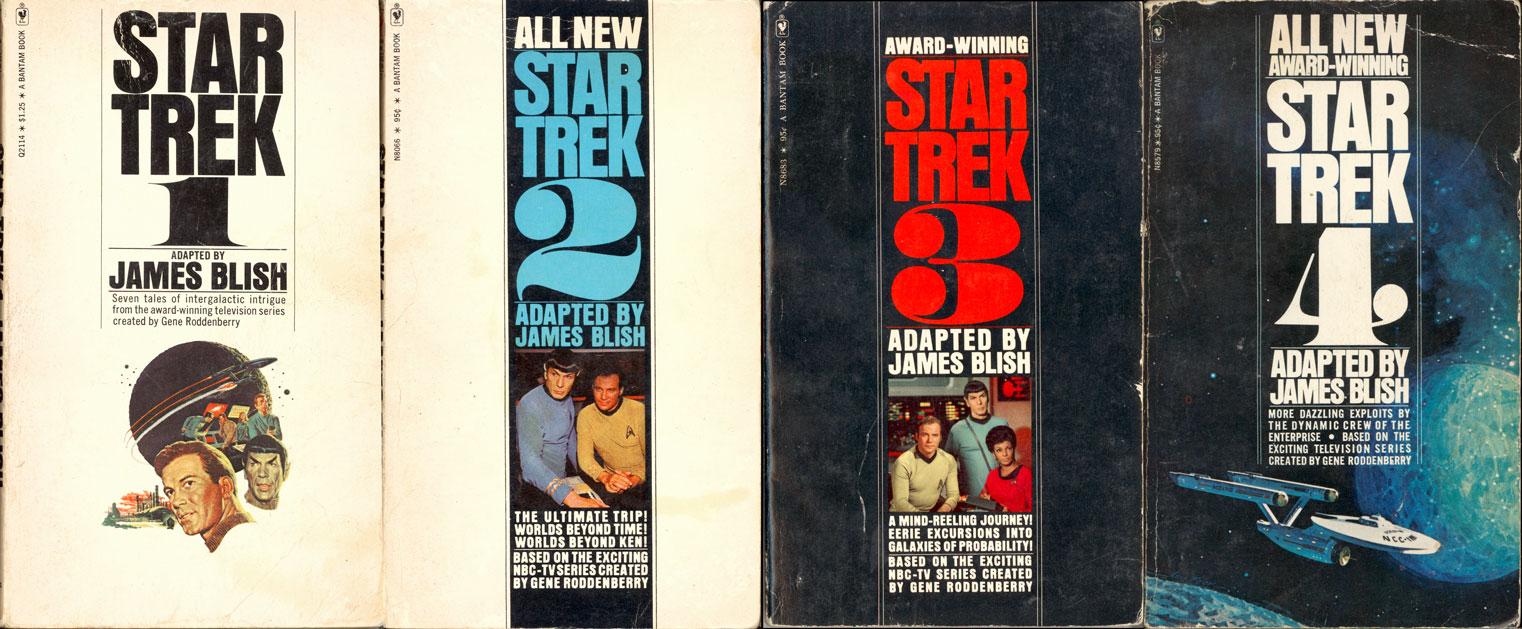
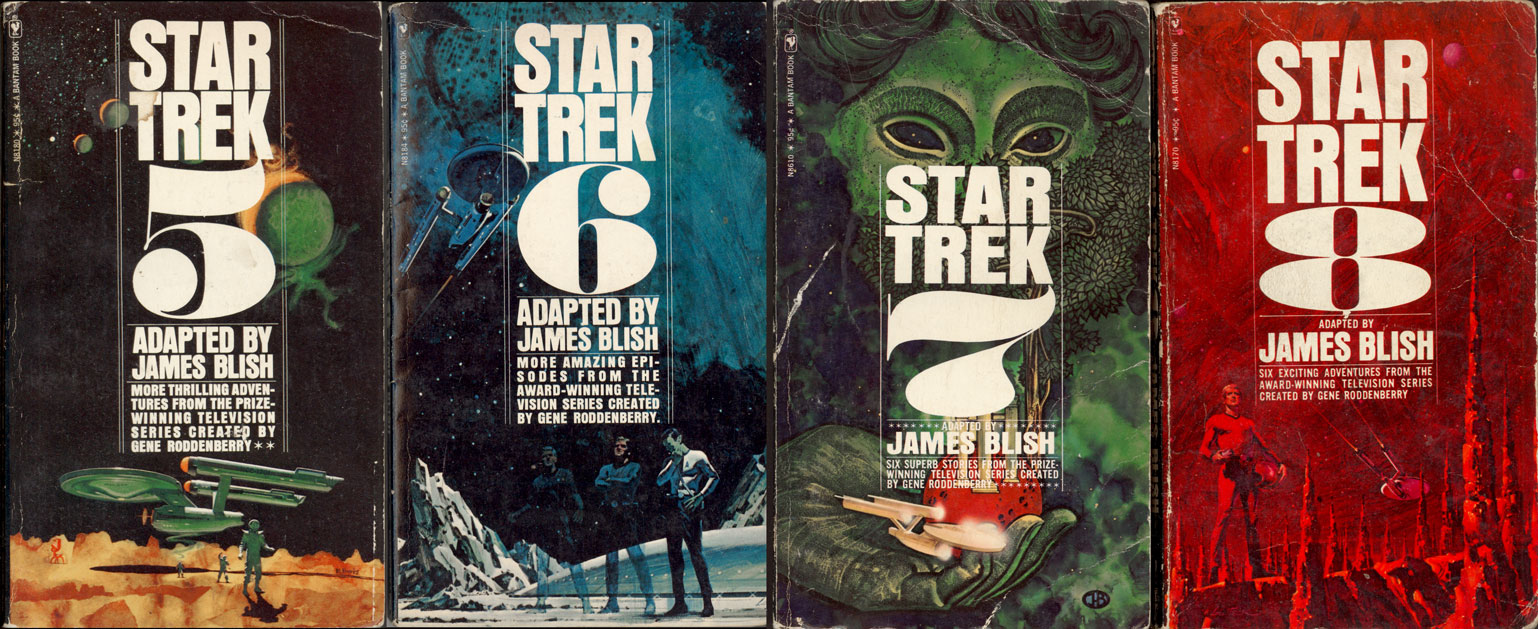
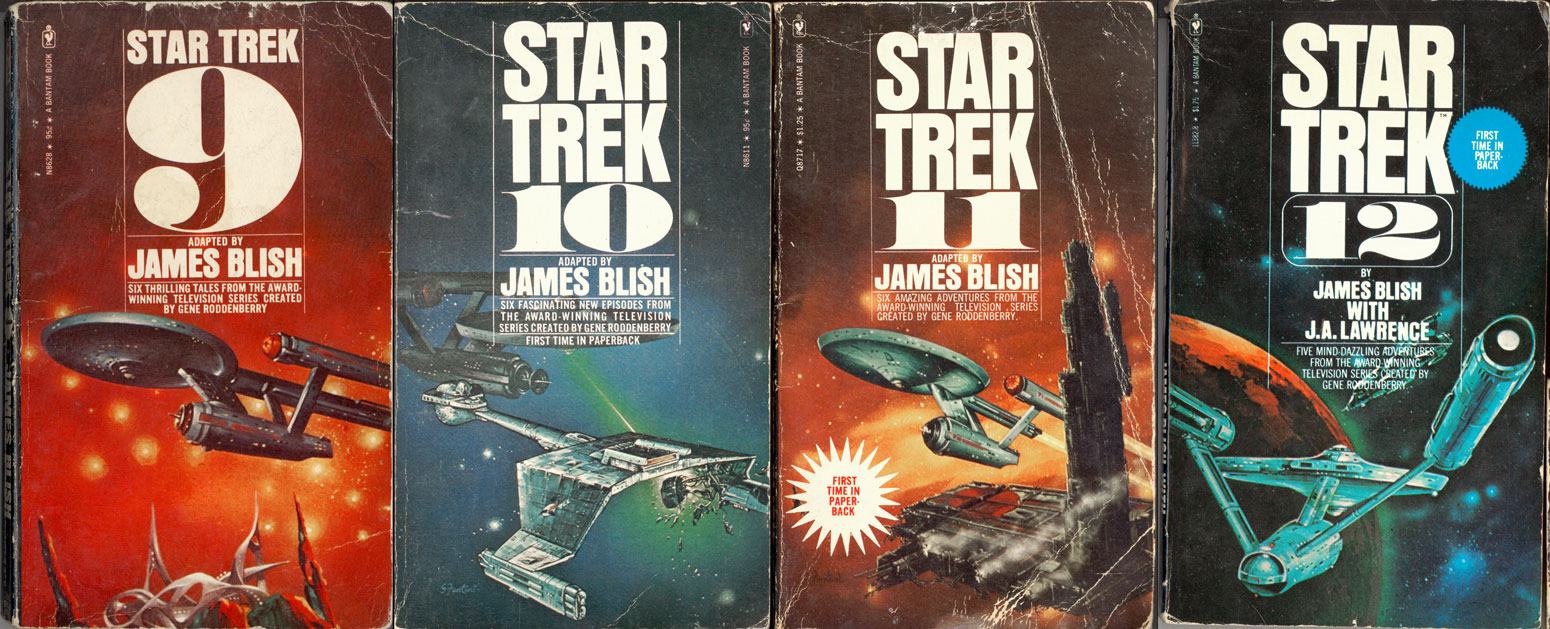
But look at the covers! (Click for larger views.) The point I tried to make in Slate was that the crudity of the filmmaking was irrelevant (“Outsiders and non-believers saw only the show’s cheap production values or overcooked performances—they didn’t understand the urgency with which our imaginations worked to fill in the blanks”). These post-psychedelic cover paintings illustrate that beautifully. Today, the equivalent material on movie screens—most recently in Guardians of the Galaxy, Jupiter Ascending, Interstellar, Prometheus, Gravity, Thor The Dark World, The Hobbit, and, of course, Star Trek Into Darkness (just to name a few routine examples from the last few years)—easily surpasses even the most perfervid expectations of hallucinogenic science fiction and fantasy visual imagery and design. But back then, it was all in our heads…and on tiny paperback covers. These are my actual, original, battered, treasured copies, which I seized from the bookstores’ wire racks and devoured when there was no other nourishment available except the black-and-white Star Trek reruns. They sustained us through the lean years; I remember them well.
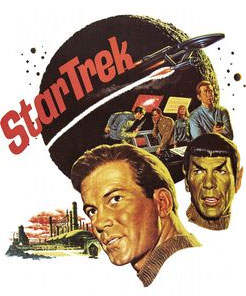
ADDENDUM: The cover to Star Trek 1 is conspicuously different. In fact, its illustration repurposes a promotional painting by American Realist James Bama (left), commissioned by Desilu/NBCTV to promote sci-fi-convention screenings of the show’s successful second pilot (“Where No Man Has Gone Before”). Technically, the reproduction of elements from that episode is perfectly accurate—but note the antiquated early-’Sixties montage style (reminiscent of the legendary Robert McGinnis James Bond posters) which stands in sharp contrast to the post-Roger Dean near-psychedelia to come. With the progression of these paperback covers you can see the ’Sixties happen.
ADDENDUM II: Paintings within paintings: a sharp-eyed examination of Bama’s montage (composed of images from the filmed episode) reveals that the view of “the Delta Vega Mining Installation” in the bottom left corner is itself a depiction of the show-stopping artwork by famous cinematic veteran matte artist Albert Whitlock (the original composite shot can be seen here).
Wednesday, November 26th, 2014
•
Cartoons
(click for full-size)
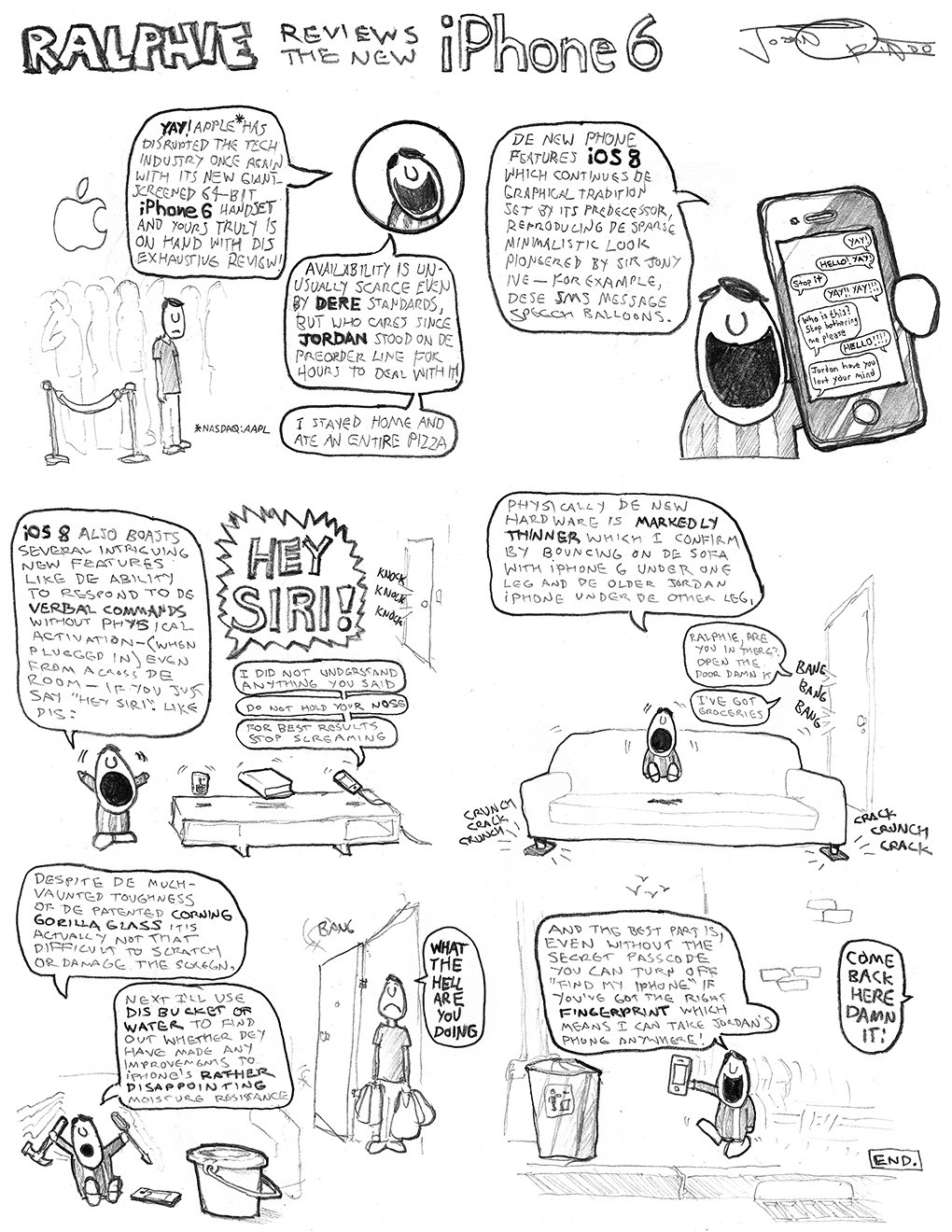
Tuesday, November 4th, 2014
•
Politics
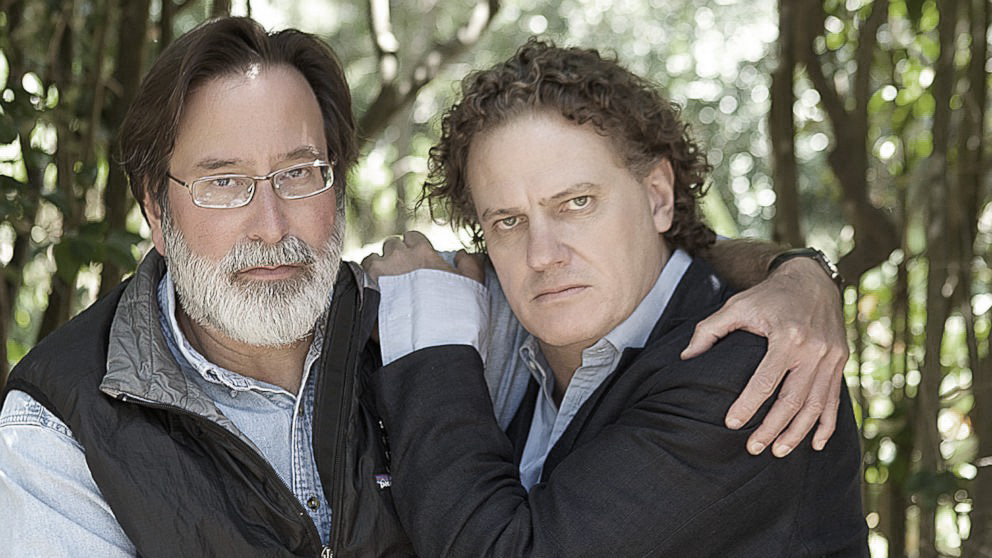
Get rid of the guns. Outlaw the handguns; forcibly take them away from all American citizens. I’m tired of everyone’s equivocation on this point. 4,350 Americans were killed with guns between January and July 2014 and 475 of them were children. Gun deaths exceeded car deaths in 14 states during the same period. The statistics are insane when compared to the rest of the world and they are insane on their own. Enough is enough.
People like to hunt; hunters “need” guns. Let’s stipulate that we want to allow hunting to continue (notwithstanding the many objections to this cruel and barbarous “sport”). So allow rifles and shotguns and other such guns for hunters but make them very difficult to find and order and make them impossible to buy without hunting permits or other proof of one’s “legitimacy” as a hunter. None of these people need or want handguns or assault weapons.
There are many gun collectors. Too bad. Take away their guns. It’s too dangerous; American lives are at stake. I’d like to “collect” uranium or dynamite, but of course I can’t. Let people go to museums to see guns. Buy gun collections from collectors and put the guns on display somewhere, or let them be on permanent loan like paintings. But take them out of homes and businesses and make them impossible to buy and illegal to own. Those people can find something else to collect, like cars or wine.
There’s a constitutional amendment involved. But its application makes use of tortuous linguistics the interpretation of which has never been agreed upon, and, anyway, there have been egregious constitutional amendments (like the 18th) that have been revoked or re-shaped by subsequent law (like the 1964 Voting Rights Act). Conservative Supreme Court Justices like Antonin Scalia like to invoke the concept of “Original Intent,” which, when applied to the 2nd Amendment, shows it to be a device to allow armed “slave patrols” to continue putting down plantation revolts in the Southern states while coexisting with the Federal army. The “Original Intent” of the amendment is contingent on a slave state.
Finally, there are people who advance a perfervid ideology they’ve invented wherein guns are “the last refuge against tyranny”—that guns are a crucial component of the fabric of American life (and our “freedoms”) because without them we’d all be “at the mercy” of a government that we cannot trust and therefore vulnerable to a “fascistic” state. We are darkly reminded that Hitler took away the guns. (Actually he didn’t.) This entire system of belief is best regarded as a species of extremely childish thinking, since it imbues physical possessions with a symbolic meaning that is somehow supposed to have concrete application. I guarantee that any group of American citizens who decide to “take on” the Federal government will lose badly, whether or not they own handguns or assault weapons. The guns are not there “to protect us from the government” (they are there to put down slave revolts). The fact that owning guns and brandishing them in public places and in living rooms and at gun shows makes these people feel better should not be of any more concern to the general public than the fact that teddy bears and security blankets make children feel better. These people need to progress to point where they can accept the adult reality of our society, where they cannot wave guns at policies (or presidents) they dislike and expect it to mean something.
This last point—the fantasy of “don’t take my guns, because that’s how tyranny starts”—is probably the most important and most difficult obstacle we face, in the drive to join the rest of the civilized world and get rid of the guns. It’s true that we’ve “always had” guns, but there are many other horrible American traditions that we’ve outgrown and overcome. The Cliven Bundy “standoff” this past March vividly illustrated what happens when this sort of comic book fable is given expression with actual firearms. It’s time for us to grow up.
Why now? After all the grim lessons of 2014, how can we wait any longer? I am not interested in Wayne LaPierre and his neanderthal bought-and-paid-for arguments that we’ve heard over and over this unusually violent and bloody year. I am not interested in grandiose statements about the “nature” or the “identity” of the United States because we all know how miraculously those things can change. I am not interested in Charlton Heston growling dramatically about his “cold dead hands.” I am interested in what happened when Elliot Rodger’s father met with Christopher Martinez’ father this past June, before the Isla Vista shooting and the Sandy Hook shooting were pushed off the public radar by more recent shootings and more deaths—more than 30,000 every year. Get rid of the guns.
Brady Campaign to Prevent Gun Violence
Project Safe Neighborhoods (U.S. Department of Justice)





